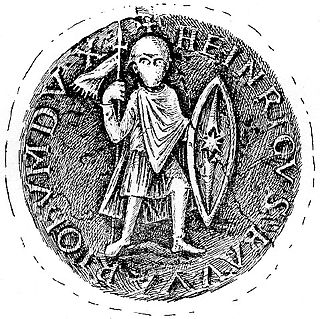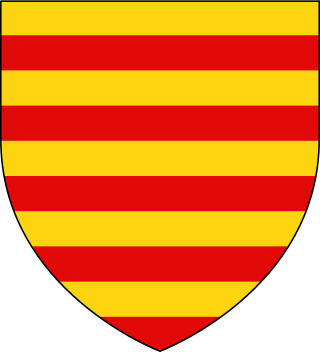
The County of Empúries, also known as the County of Ampurias, was a medieval county centred on the town of Empúries and enclosing the Catalan region of Peralada. It corresponds to the historic comarca of Empordà.

The County of Loon was a county in the Holy Roman Empire, which corresponded approximately with the modern Belgian province of Limburg. It was named after the original seat of its count, Loon, which is today called Borgloon. During the middle ages the counts moved their court to a more central position in Kuringen, which today forms part of Hasselt, capital of the province.
Gausfred I was the count of Empúries and Rosselló from 931 until his death. He was the son and successor of Gausbert. He spent his whole life consolidating his authority in his counties, but he divided the realm amongst his sons. By his testament of 989, Empúries and Perelada went to Hugh and Roussillon went to Giselbert.
Giselbert I, count of Roussillon (991–1013), was the son of Gausfred I. His father divided his lands between his sons, giving Ampurias to Hugh and Roussillon to Giselbert.

Henry VII was the count of Luxembourg from 1026 and duke of Bavaria from 1042 until his death. He was a son of Frederick of Luxembourg, count of Moselgau, and possibly Ermentrude of Gleiberg.
Gausfred II was the count of Roussillon from 1013 or 1014 to his death. He was the son and successor of Count Giselbert I, who was also count of Empúries, and Beliarda.

Gausfred III was the count of Roussillon from 1113 until his death. He was the son and successor of Girard I, who was assassinated, leaving Gausfred a child. Arnold Gausfred, the young count's uncle, acted as regent until 1121.
Gerard II was the last de facto independent count of Roussillon from 1164 to his death in 1172. He was the son and heir of Gausfred III.
Hugh I, Count of Empúries (Ampurias) from 991, was the son of Gausfred I and his first wife, Ava, daughter of Raymond II of Rouergue.
Robert of Vermandois was Count of Meaux from 946 to his death and Count of Troyes from 956 to his death.
Ebles I of Roucy was count of Roucy from 1000 to 1033 and archbishop of Reims from 1021 to 1033.
Hugh II was the Count of Empúries from 1078 until his death. He was the eldest son of Ponç I and Adelaida de Besalú, and succeeded his father in Empúries while his brother, Berenguer, was given the Viscounty of Peralada.
Giselbert van Loon is the first definitely known count of the County of Loon, a territory which, at least in later times, roughly corresponded to the modern Belgian province of Limburg, and generations later became a lordship directly under the Prince-bishopric of Liège. Very little is known about him except that he had two brothers, one of whom, Bishop Balderic II of Liège, is much better attested in historical records.
Gilbert, Count of Reims & Roucy, was the son of Renaud, Count of Reims and Alberade of Lorraine, daughter of Gilbert, Duke of Lorraine. Although his wife's name is unknown, she was likely from the family of the Poitiers. He was Count of Roucy from 967 until his death, and Viscount of Reims.
Otto II, Count of Chiny, son of Arnold I, Count of Chiny, and Adélaïs.
Alfonso de Aragón y Portugal, or Alfonso I de Ampurias, was Count of Ampurias and Duke of Segorbe.

Arnold II, Count of Loon, son of Arnold I, Count of Loon, and Agnes von Mainz, daughter of Gerhard I, Count of Rieneck, and Helwig von Bliescastel. He is distinguished from his father of the same name by historians who note records for counts named Arnold or Arnulf between 1179 and 1141. The first Arnold must have died between 1125 when Count Arnold appears in a record with his son also named Arnold, and 1135, when a new Count Arnold appears with his own son and successor Louis.
Count Giselbert of Loon or (later) Duras, was the deputy advocate (subadvocatus) of Saint Trudo’s Abbey. He was son of Count Otto, the younger brother of Count Emmo of Loon. Giselbert was the first person to be named in contemporary documents as a count of Duras.
Conon was a Lotharingian nobleman and military leader of the First Crusade. He was one of the most prominent lords of the Ardennes, being the count of Montaigu, lord of Rochefort and advocate (defender) of the city of Dinant from 1064. He was also one of the most important vassals of the bishop of Liège. His chief seat was the castle of Montaigu.

In the 10th through 13th centuries, the Lords of Esch were the holders of the castle of Esch-sur-Sûre in the Ardennes region of Lower Lorraine, then a part of the Holy Roman Empire.






